Key takeaways:
- Charitable donations stem from personal connections and evoke a sense of purpose for both givers and receivers.
- Effective networking is crucial in fundraising, leading to lasting relationships and collaborative opportunities.
- Building genuine relationships with donors involves understanding their stories, engaging personally, and maintaining transparent communication.
- Follow-up communication is vital; it enhances relationships, reinforces connections, and can lead to unexpected support.
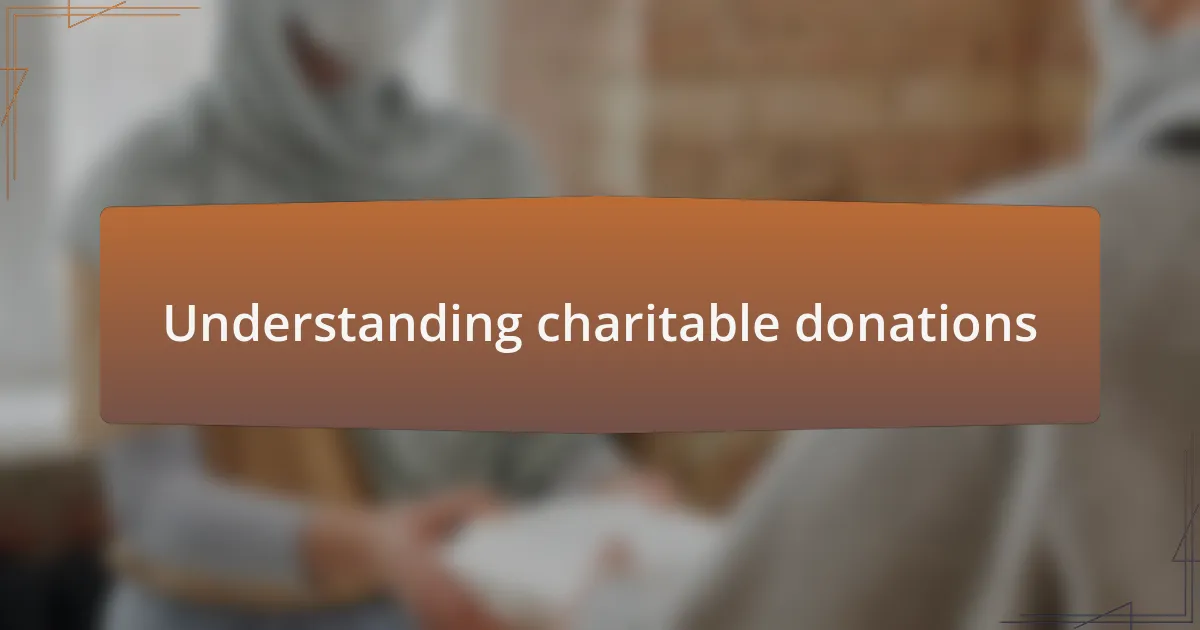
Understanding charitable donations
Understanding charitable donations is about grasping the motivations and values that underpin them. From my own experiences, I’ve realized that when people give, it often stems from a deeply personal connection to a cause. For instance, I once met a donor who supported a children’s hospital because she had spent a significant part of her childhood there. Her donation wasn’t just about money; it represented gratitude and a desire to give other children hope.
I’ve also seen that the act of donating can evoke a profound sense of purpose, both for the giver and the receiver. Have you ever considered how a small act of kindness can ripple through an entire community? One time, I witnessed a local charity event where every donation helped provide meals for families in need. The smiles and gratitude on those faces were priceless, and it struck me how a simple act of generosity could transform lives.
Charitable donations are not merely transactions; they are expressions of empathy and shared humanity. Reflecting on my interactions with various donors, it’s clear that many give to feel part of something greater. The sense of belonging and commitment to a shared vision can be incredibly powerful. What if we all recognized the immense impact we could have by engaging with our communities and supporting causes that matter to us? That’s a thought worth exploring.
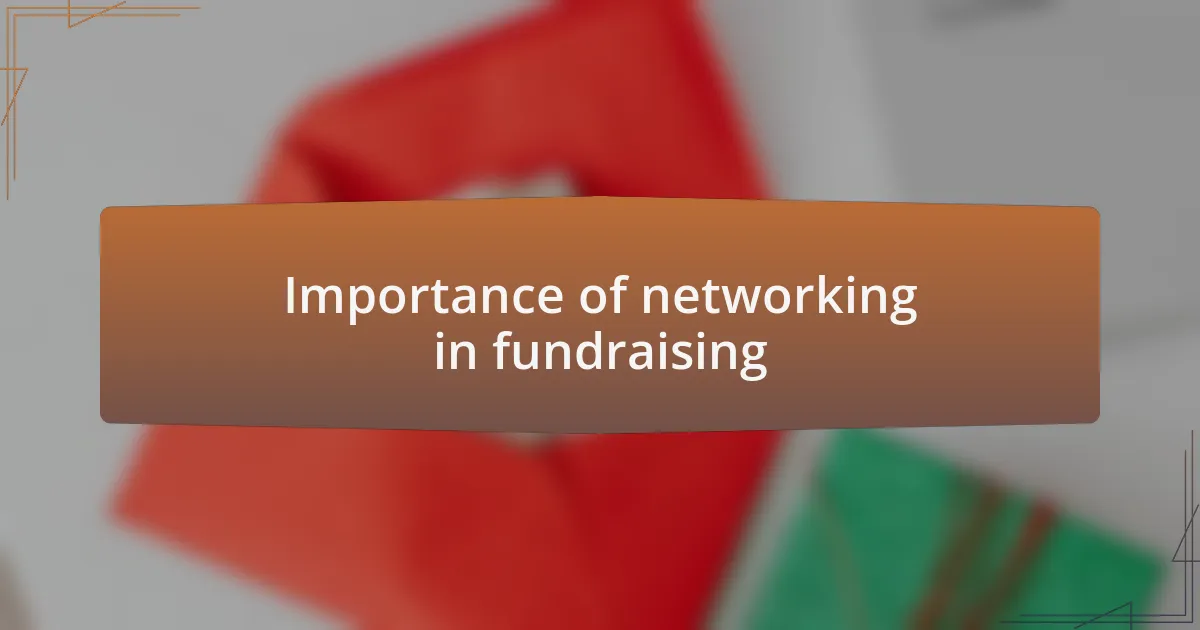
Importance of networking in fundraising
Building connections through networking is vital in fundraising. I remember attending a charity gala where I met several influential donors. Engaging in meaningful conversations with them opened doors I hadn’t even considered before. Their insights enriched my understanding of what motivates giving, and that knowledge has been invaluable in my fundraising efforts.
Effective networking can lead to long-lasting relationships that extend beyond a single donation. One particularly rewarding experience involved collaborating with a donor who not only provided financial support but also shared their extensive professional network. Their willingness to introduce me to others amplified our reach, illustrating the power of united efforts in charitable initiatives. How can we leverage our networks to create something larger than ourselves? It’s a thought that inspires me.
Moreover, networking fosters a sense of community and shared purpose within the fundraising realm. I recall a time when I was part of a small group that brainstormed ideas to enhance donor engagement. The diverse perspectives everyone brought to the table ignited my passion and sparked innovative ideas. In those moments, I realized how crucial it is to cultivate these relationships, as they can transform an idea into a collective impact. Can you imagine the changes we could effect if we all leaned into our networks?
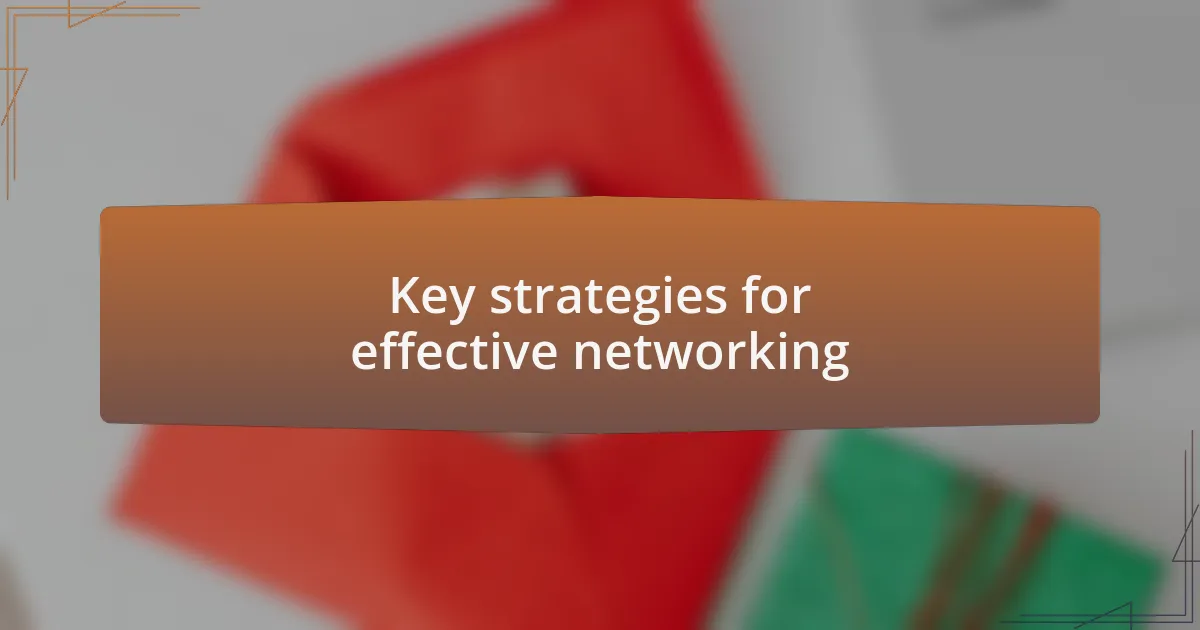
Key strategies for effective networking
One key strategy for effective networking is to approach every interaction with genuine curiosity. During one networking event, I struck up a conversation with a donor whose passion for environmental initiatives resonated with me. By actively listening and asking thoughtful questions about their interests, I was able to connect on a personal level. This authentic exchange not only deepened our conversation but also led to potential collaboration on future projects. Are we often enough tuned in to the passions that drive our donors?
Another important tactic is to follow up after initial meetings. I vividly recall reaching out to a donor weeks after a chance encounter at a conference. I sent a personalized email, recalling specific details from our conversation and expressing appreciation for their insights. This simple gesture not only reinforced our connection but also kept our dialogue alive. How many opportunities do we miss by not maintaining these relationships?
Lastly, leveraging social media can be a powerful tool in networking. I have experienced firsthand how platforms like LinkedIn can help maintain relationships and stay updated on donors’ interests. By sharing relevant content and celebrating their successes, you show that you care beyond just seeking donations. It creates a cycle of engagement that can lead to invaluable partnerships. What steps can we take to enhance our online presence in the charitable landscape?
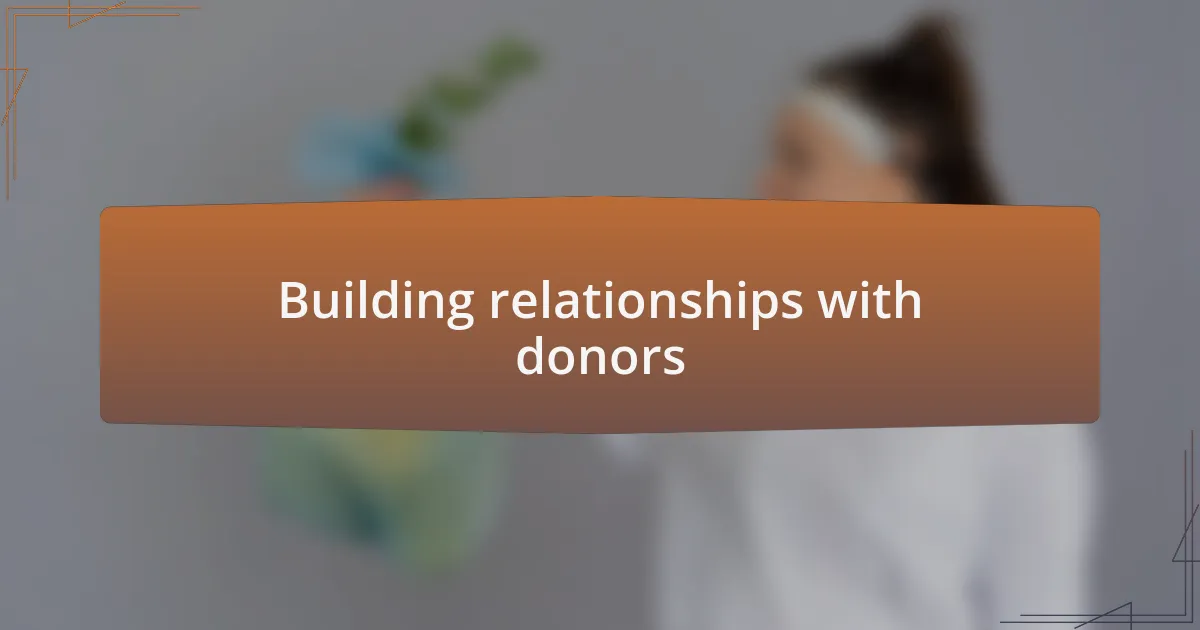
Building relationships with donors
Building relationships with donors is more than just a transaction; it’s about connection. I remember a time when a donor shared a heartwarming story about how their late grandmother inspired their philanthropic journey. That moment wasn’t just informative; it made me realize that each donor comes with their own narrative, and understanding these can cultivate a deeper relationship. How often do we take the time to unravel the personal stories behind the donations?
Engaging with donors on a personal level can create meaningful bonds. I once had a coffee meeting with a long-time supporter who revealed her struggle with finding causes that aligned with her values. By discussing potential projects together over a cup of coffee, we not only ignited her enthusiasm but also solidified a partnership based on shared ideals. It struck me—what could happen if we created more spaces for these types of conversations?
Additionally, being transparent and genuine in our communication fosters trust. After sending out a detailed impact report to a group of donors, one reached out with a heartfelt message, sharing how the report inspired him to bring his friends aboard. That feedback was eye-opening; it underscored the power of open dialogue. Have we considered how being candid with our donors can lead to unexpected support?
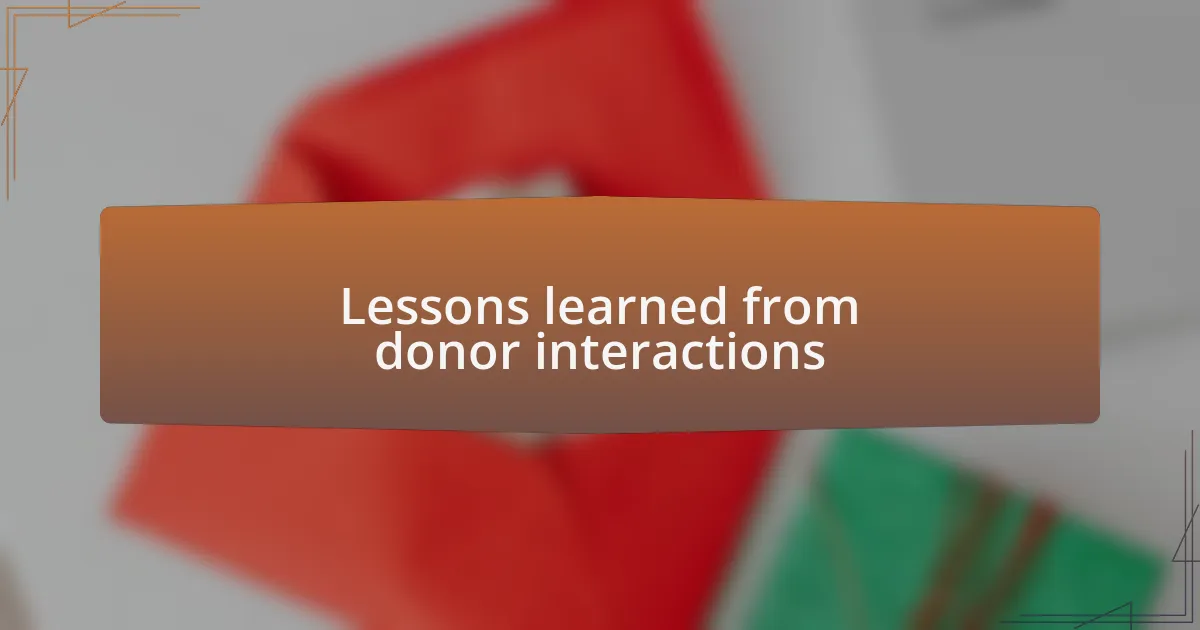
Lessons learned from donor interactions
Interacting with donors has taught me the importance of active listening. During one interaction, I asked a donor about their motivations for supporting our cause, and their face lit up as they shared the profound impact that a similar project had on their community. It was a reminder that sometimes, the most valuable insights come from simply giving our full attention to what donors have to say. Have we truly been hearing what our donors are telling us, or are we just waiting for our turn to speak?
I’ve also learned that following up is crucial for nurturing these relationships. I once sent a thank-you note to a new donor who had generously contributed to our initiative. To my surprise, they replied with a detailed account of their own charitable journey, expressing their hopes for future collaborations. This interaction highlighted how a small gesture can lead to deeper conversations and future opportunities. What if we made following up a regular part of our practice?
Lastly, I often reflect on the value of sharing success stories. After showcasing the measurable impact of a funded project in our newsletter, several donors responded, eager to learn about upcoming opportunities. It reinforced my belief that celebrating our collective achievements not only acknowledges donors’ contributions but also inspires them to get more involved. How can we consistently capture and share these stories to fuel ongoing engagement?
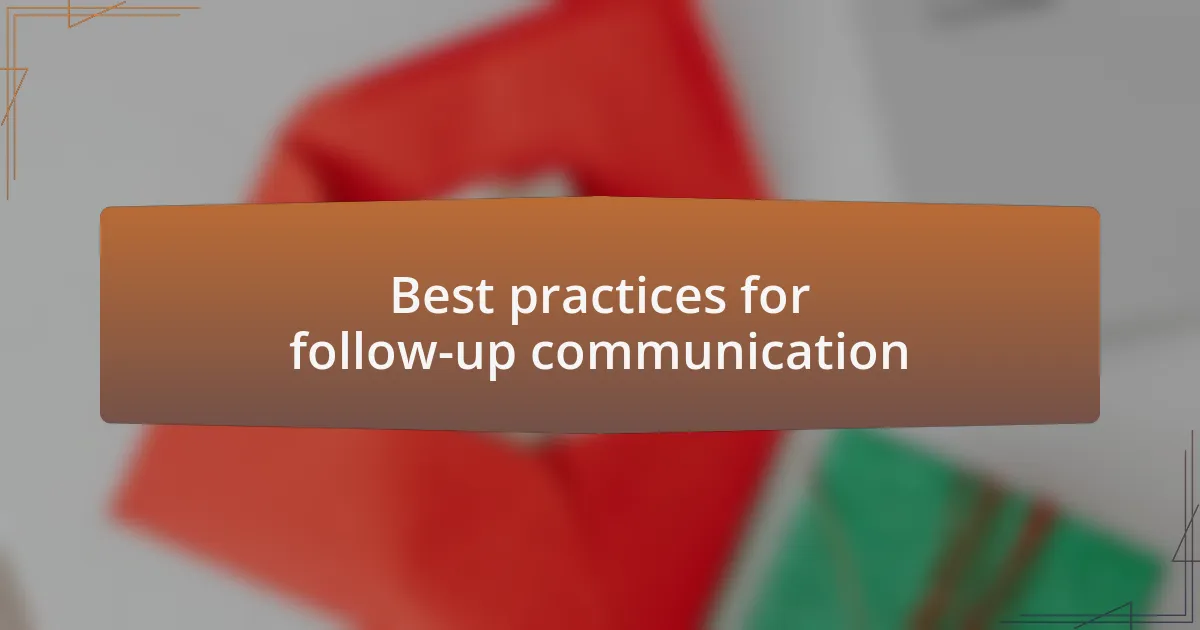
Best practices for follow-up communication
Following up with donors is an art that requires intentionality. I remember one time, I reached out to a donor three months after a significant contribution to ask for their feedback on our project. To my surprise, they appreciated the outreach and provided constructive suggestions, which ultimately enhanced our efforts. It’s these moments that make me wonder: are we maximizing each interaction to foster collaborative growth?
Timing is a critical aspect of follow-up. A few weeks after a donor event, I noticed a drop in engagement from attendees. I decided to send a personalized email, highlighting specific conversations we had during the event. This simple act reignited their interest and prompted them to get back in touch. Are we giving enough thought to when we communicate, or are we defaulting to generic timelines that don’t resonate?
And let’s not underestimate the power of gratitude. I once sent an unexpected handwritten card to a donor who had moved on from regular contributions. The warmth expressed in that personal touch led them to reconnect and eventually contribute again. Isn’t it fascinating how a small gesture of thanks can restore connections that might seem lost?